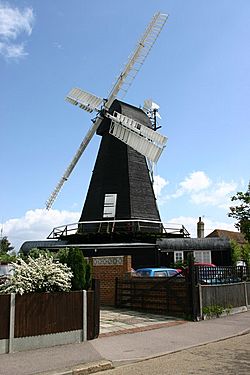Herne Windmill facts for kids
Quick facts for kids Herne Windmill |
|
|---|---|
 |
|
| Origin | |
| Grid reference | TR 185 665 |
| Coordinates | 51°21′19″N 1°8′13″E / 51.35528°N 1.13694°E |
| Operator(s) | Kent County Council |
| Year built | 1789 |
| Information | |
| Purpose | Corn mill |
| Type | Smock mill |
| Storeys | Three-storey smock |
| Base storeys | Two-storey base |
| Smock sides | Eight-sided |
| No. of sails | Four |
| Type of sails | Double Patent sails |
| Windshaft | Cast iron |
| Winding | Fantail |
| Fantail blades | Six blades |
| Auxiliary power | Steam engine Oil engine Electric motor since 1952 |
| No. of pairs of millstones | Three |
| Other information | Originally built on a single-storey base, raised in 1858 to two storeys |
Herne Windmill is a very important historical building. It is a type of windmill called a smock mill located in Herne, Kent, England. This amazing windmill was built way back in 1789.
Contents
The Mill's Long History
Herne Windmill was built in 1789 by a person named John Holman. He was a skilled mill builder at the time. Windmills have been in Herne for a very long time, even since 1405! This mill replaced an older type of windmill, called a post mill, which was there in 1511. The old mill was even shown on old maps from the 1500s and 1600s.
Changes Over the Years
In 1858, the windmill was made taller. A new two-storey brick base was built underneath it. This made the mill even more impressive. Later, in 1931, an important part called an iron worm was replaced. It helped the mill's machinery work smoothly.
In the 1930s, the mill was only working with two of its four sails. Frank Wootton, who was the miller, asked for help from a group called the Society for the Protection of Ancient Buildings (SPAB). They helped arrange for two new sails to be brought from another mill in Norfolk in 1936.
New Sails and Power
A brand new set of sails was built for the mill. This was possible thanks to help from SPAB, the Duchess of Kent, and Trinity House. Trinity House helped because the windmill was a useful landmark for ships at sea.
The mill used wind power until 1952. Sometimes, a steam engine or an oil engine helped it work. After 1952, an electric motor was used to grind the corn. The mill continued to operate with the electric motor until 1980.
Recent Events
On May 21, 2020, the sails of the windmill were carefully removed. This happened during the first lockdown of the COVID-19 pandemic.
How Herne Windmill Works
Herne Mill is a smock mill with three main floors. It sits on a two-storey brick base. It has four special sails called double patent sails. These sails are attached to a strong cast-iron shaft. The top part of the mill, called the cap, is in a style common in Kent.
Turning to the Wind
The mill has a fantail at the back. This fantail automatically turns the cap and sails so they always face the wind. This is very clever! There is also a platform, or stage, between the first and second floors.
Inside the Mill
Inside, the mill has a large gear wheel called the Brake Wheel. It is made of both iron and wood. This wheel turns a wooden gear called a Wallower, which is on a long wooden Upright Shaft. This shaft then turns another large gear called the Great Spur Wheel. This system helps to power the three pairs of millstones. These millstones grind the corn from above.
Newer Sails
In 2004, new sails were put on the mill. Each sail is about 10.15 meters (33 feet 3.75 inches) long and 1.79 meters (5 feet 10.75 inches) wide. When all four sails are on, they span about 20.93 meters (68 feet 8 inches) across.
Millers of Herne Windmill
Many families have worked as millers at Herne Windmill over the years. Here are some of them:
- Webb
- (Job) Lawrence & Sons (John and Edward) 1795 - 1879
- John Lawrence (nephew of Job) 1763 - 1840
- Edward Lawrence 1845 -
- Thomas Wootton 1879 - 1928
- Frank Wootton
- R C & E E Wootton
- Clive Wootton 1925 - 1980
- Robert Wootton

